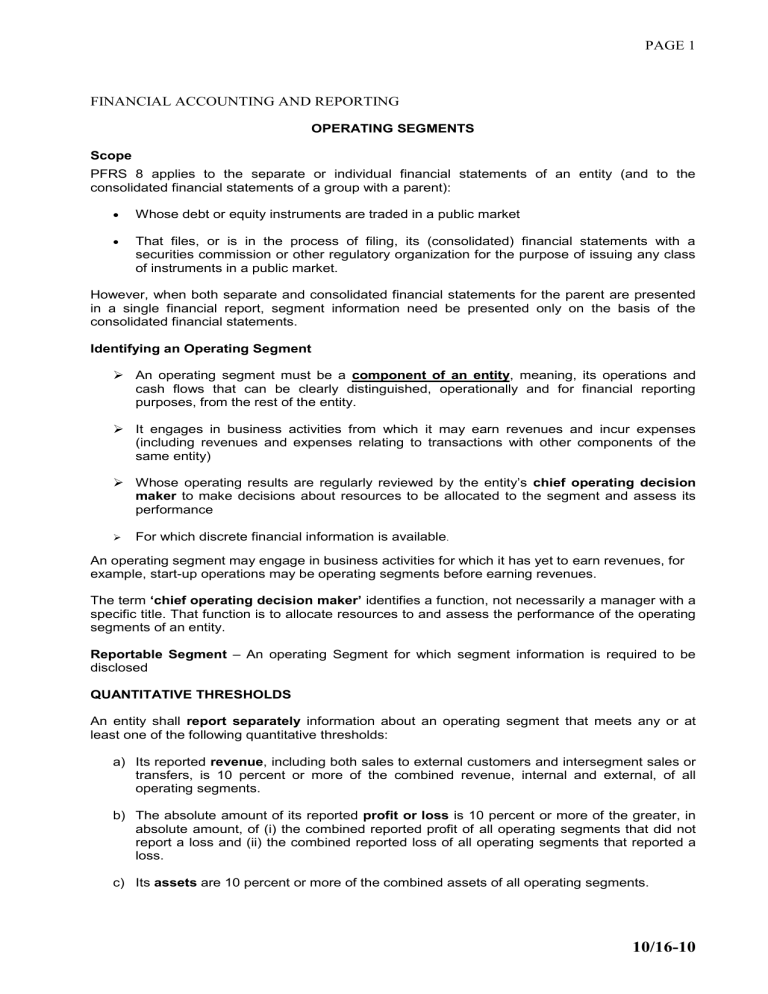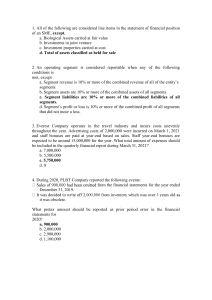
PAGE 1 FINANCIAL ACCOUNTING AND REPORTING OPERATING SEGMENTS Scope PFRS 8 applies to the separate or individual financial statements of an entity (and to the consolidated financial statements of a group with a parent): Whose debt or equity instruments are traded in a public market That files, or is in the process of filing, its (consolidated) financial statements with a securities commission or other regulatory organization for the purpose of issuing any class of instruments in a public market. However, when both separate and consolidated financial statements for the parent are presented in a single financial report, segment information need be presented only on the basis of the consolidated financial statements. Identifying an Operating Segment An operating segment must be a component of an entity, meaning, its operations and cash flows that can be clearly distinguished, operationally and for financial reporting purposes, from the rest of the entity. It engages in business activities from which it may earn revenues and incur expenses (including revenues and expenses relating to transactions with other components of the same entity) Whose operating results are regularly reviewed by the entity’s chief operating decision maker to make decisions about resources to be allocated to the segment and assess its performance For which discrete financial information is available. An operating segment may engage in business activities for which it has yet to earn revenues, for example, start-up operations may be operating segments before earning revenues. The term ‘chief operating decision maker’ identifies a function, not necessarily a manager with a specific title. That function is to allocate resources to and assess the performance of the operating segments of an entity. Reportable Segment – An operating Segment for which segment information is required to be disclosed QUANTITATIVE THRESHOLDS An entity shall report separately information about an operating segment that meets any or at least one of the following quantitative thresholds: a) Its reported revenue, including both sales to external customers and intersegment sales or transfers, is 10 percent or more of the combined revenue, internal and external, of all operating segments. b) The absolute amount of its reported profit or loss is 10 percent or more of the greater, in absolute amount, of (i) the combined reported profit of all operating segments that did not report a loss and (ii) the combined reported loss of all operating segments that reported a loss. c) Its assets are 10 percent or more of the combined assets of all operating segments. 10/16-10 PAGE 2 Operating segments that do not meet any of the quantitative thresholds may be considered reportable, and separately disclosed, if management believes that information about the segment would be useful to users of the financial statements. OVERALL SIZE TEST If total external revenue attributable to reportable segments identified using the 10% quantitative thresholds is less than 75% of the total consolidated or enterprise revenue (external revenue), additional segments should be identified as reportable segments, even if they do not meet the 10 % requirement. Until at least 75% of total consolidated or enterprise revenue is included in reportable segments. In other words, the quantitative thresholds will not be necessary in determining additional reportable segments in order to meet the 75% requirement. DISCLOSURES REQUIRED FOR REPORTABLE SEGMENTS An entity shall disclose information to enable users of its financial statements to evaluate the nature and financial effects of the business activities in which it engages and the economic environments in which it operates. Disclosures will include a) General information - Factors used to identify the entity’s reportable segments, including the basis of organization and types of products and services from which each reportable segment derives its revenues. b) Information about reported segment profit or loss c) Reconciliations of the totals of segment revenues, reported segment profit or loss, segment assets, segment liabilities and other material segment items to corresponding entity amounts ENTITY WIDE DISCLOSURES: a) Information about products and services b) Information about geographical areas c) Information about major customers - If revenues from transactions with a single external customer amount to 10 per cent or more of an entity’s revenues, the entity shall disclose that fact and disclose the following: a. The total amount of revenues from each such customer b. The identity of the segment or segments reporting the revenues. - - END - - 10/16-10



